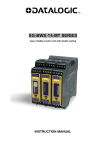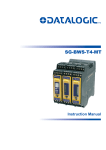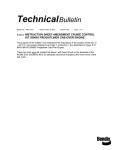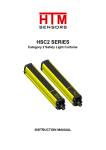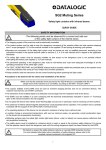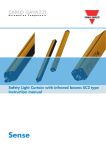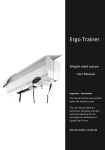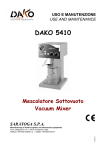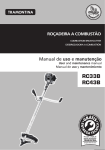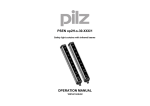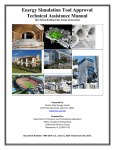Download SG-BWS-T4 - Datalogic
Transcript
SG-BWS-T4
Instruction Manual
ORIGINAL INSTRUCTIONS (ref. 2006/42/EC)
Datalogic Automation S.r.l.
Via Lavino, 265
40050 - Monte S. Pietro
Bologna - Italy
SG BWS-T4 Instruction Manual
Ed.: 08/2012
© 2012 Datalogic Automation S.r.l. ALL RIGHTS RESERVED. Protected to the fullest extent under U.S.
and international laws. Copying, or altering of this document is prohibited without express written consent
from Datalogic Automation S.r.l.
Datalogic and the Datalogic logo are registered trademarks of Datalogic S.p.A. in many countries, including
the U.S.A. and the E.U.
All brand and product names mentioned herein are for identification purposes only and may be trademarks
or registered trademarks of their respective owners.
Datalogic shall not be liable for technical or editorial errors or omissions contained herein, nor for incidental
or consequential damages resulting from the use of this material.
07/08/12
INDEX
1. GENERAL INFORMATION ........................................................................................................................1
1.1.
1.2.
1.3.
Purpose of this document:............................................................................................................................... 1
Intended readers: ............................................................................................................................................ 1
Usage information: .......................................................................................................................................... 1
2. PRODUCT GENERAL DESCRIPTION......................................................................................................2
2.1.
2.2.
2.3.
2.4.
2.5.
Package Content ............................................................................................................................................. 2
Products components and interface ................................................................................................................ 2
Safety sensors................................................................................................................................................. 3
Main functions managed by the control unit: ................................................................................................... 4
Typical Applications......................................................................................................................................... 4
3. INSTALLATION..........................................................................................................................................6
3.1.
3.2.
3.3.
3.4.
3.5.
3.6.
3.7.
3.8.
Safety information............................................................................................................................................ 6
Precautions to be observed for the choice and installation of the device ........................................................ 6
General information on sensors positioning .................................................................................................... 6
Minimum installation distance.......................................................................................................................... 7
Minimum distance from reflecting surfaces ..................................................................................................... 9
Sensors Interference ..................................................................................................................................... 10
Installing the safety control unit ..................................................................................................................... 11
Installing the sensors..................................................................................................................................... 11
4. ELECTRICAL CONNECTION ..................................................................................................................13
4.1.
4.2.
4.3.
4.4.
4.5.
4.6.
4.7.
Important installation tips............................................................................................................................... 13
External relays connection for machine control ............................................................................................. 13
Minimum connections (1 photocell, no EDM, automatic restart).................................................................... 14
Complete list of connections.......................................................................................................................... 15
Connecting the safety photocells:.................................................................................................................. 16
Connecting the external relays and EDM ...................................................................................................... 17
Reset mode and connection of the Start/Test/Reset push-button ................................................................. 18
5. COMMISSIONING ....................................................................................................................................20
5.1.
5.2.
Screen indications upon switch-on ................................................................................................................ 20
Safety devices alignment............................................................................................................................... 20
6. DIAGNOSTICS AND WARNINGS ...........................................................................................................21
6.1.
6.2.
Normal operation signalling ........................................................................................................................... 21
Failure state signalling................................................................................................................................... 22
7. PERIODICAL CHECKS AND WARRANTY.............................................................................................23
7.1.
7.2.
Periodical checks........................................................................................................................................... 23
Warranty........................................................................................................................................................ 23
8. DEVICE MAINTENANCE .........................................................................................................................24
8.1.
Product disposal ............................................................................................................................................ 24
9. TECHNICAL DATA ..................................................................................................................................25
10.ORDER DATA ..........................................................................................................................................26
11.OVERALL DIMENSIONS .........................................................................................................................28
11.1. SG-BWS-T4 .................................................................................................................................................. 28
11.2. S5-ST2,S5-ST4, SL5-ST4, S300................................................................................................................... 28
12.APPENDIX................................................................................................................................................29
12.1. FIGURE INDEX: ............................................................................................................................................ 29
12.2. TABLES INDEX:............................................................................................................................................ 29
Instruction Manual
1.
SG-BWS-T4
GENERAL INFORMATION
Read this section carefully before implementing the instructions given in this manual and starting up
the SG-BWS-T4 safety system.
1.1.
Purpose of this document:
These instructions for use are addressed to the manufacturer technicians or staff operating the
machine and give all necessary instructions for correct and safe assembly, setup, electric connection
and commissioning of the SG-BWS-T4 safety system.
Scope of this document excludes information about use of the machine the safety system is installed
to.
1.2.
Intended readers:
The instructions for use given herein are addressed to designers, manufacturers and persons in
charge of the safety of systems to be equipped with the SG-BWS-T4. They are also addressed to the
staff in charge of installing the SG-BWS-T4 to a machine, commissioning it or servicing it.
1.3.
Usage information:
These instructions for use contain the following details about the SG-BWS-T4:
- installation
- electrical connection
- commissioning and setup
- application
- diagnostics and troubleshooting
- user interface warnings
- conformity and type approval
- care and maintenance
Tab. 1 User manual main contents
Designing and using safety devices to integrate to the SG-BWS-T4 requires specific know-how which
is not included in this document. In particular, the applicable industry standards shall be met.
General information about accident-prevention protection by means of optoelectronic safety devices
can be found in the “Safety guide” available on the product CD provided with SG-BWS-T4.
Acronyms used:
ESPE
EDM
OSSD
LED
Electro sensitive protective equipment: used instead of SG-BWS-T4
External device monitoring
Output signal switching device: output signal that can control an external safety circuit.
Light emitting diode
Definitions, symbols used:
Constant viewing of characters, e.g. A
Alternated viewing of characters, e.g. U and 5
SAFE
NORMAL
NORMAL
The red LED is always ON
The LED is OFF
The green LED flashes
Warning: indicates safety-related critical information. Carefully read and follow
given instructions.
1
SG-BWS-T4
Instruction Manual
2.
PRODUCT GENERAL DESCRIPTION
2.1.
Package Content
Safety Control Unit SG-BWS-T4
Quick operations guide
Cd-Rom with this user manual and other contents
Six-monthly checklist for periodic check and maintenance
2.2.
Products components and interface
1| 2| 3| 4
5| 6| 7| 8
POWER
Power
NORMAL
Safe
SAFE
Break
9|10|11|12
13|14|15|16
Fig. 1 SG-BWS-T4-MT Appearance and user interface
SG-BWS-T4 safety system consists of a control unit enclosed in a plastic housing to be installed on
OMEGA/DIN rail equipped with 16 screw clamps that can be connected up to 4 sets of photocells of
the S5-ST, SL5-ST, S300 series.
System was designed making reference to the following regulations and standards:
EN 61496-1: 2004
CLC/TS 61496-2: 2006
Safety of machinery: electrosensitive protective equipment. Part 1:
General requirements and tests.
Safety of machinery: electro-sensitive protective equipment.
Particular requirements for equipment using active optoelectronic
protective devices.
The control unit fits two safety outputs (OSSD) controlled according to the status of each and every
sensor connected to the system: when a photocell detects any dangerous condition, this disables the
outputs and stops the machine, duly connected to OSSD.
At the top of SG-BWS-T4 is user interface for viewing warnings.
2
Instruction Manual
SG-BWS-T4
Further to the 7-segment display (for diagnostics purposes) the warning components include 3 LEDs:
LED
Indication
POWER
NORMAL
SAFE
Device is powered correctly
Safety outputs closed
Safety outputs open
Tab. 2 Signalling LEDs
2.3.
Safety sensors
4 types of photocells can be connected to the safety control unit:
S5-5-X-X-SG-ST2: Type 2 safety photocell emitting infrared beams.
S5-5-X-X-SG-ST4: Type 4 safety photocell emitting infrared beams.
SL5-5-X-X-SG-ST4: Type 4 safety photocell emitting long-distance red laser beam.
S300-5-X-X-ST4: Type 4 safety photocell for long-distance applications.
See section 10 “Order data” for further details about available photocell models.
Using the above photocells independently from SG-BWS-T4 does not meet EN
61496-1 and CLC/TS 61496-2 requirements and is thus not allowed.
Connection of Type 2 photocells results in the whole system category downgrade
to Type 2.
S5 and SL5 sensors are housed in plastic tube casings featuring M18x1 thread.
Fig. 2 Safety single beam photocells S5,SL5 series (appearance)
The photocells are equipped with LEDs for operation status indication:
SENSOR
LED
INDICATION
S5/SL5/S300 Emitter
Green
Sensor correctly powered
S5 Receiver
Green
/ Green
Red
Red
Sensor correctly powered
Poor/insufficient signal received
Output active
Output not active
SL5/S300 Receiver
Green
/ Green
Yellow
Yellow
Sensor correctly powered
Poor/insufficient signal received
Output active
Output not active
Tab. 3 Photocells signalling
Please refer to the relevant user manual for further details about photocells operation.
3
SG-BWS-T4
2.4.
Instruction Manual
Main functions managed by the control unit:
Manual/Automatic restarting: select whether the safety outputs are automatically closed when
danger condition no longer applies or if this should happen after a manual enabling command output
through a restarting selector.
EDM: the control unit can monitor any external contactors possibly connected downstream.
2.5.
Typical Applications
The SG-BWS-T4 system is typically used as a protection to the access to dangerous areas on
machines or systems. The sensors are fixed and installed to the access area at the suitable safety
distance from the nearest danger source and output a stop control to the machine or system, if the
light beam is interrupted.
Hereafter are shown some application examples with SG-BWS-T4.
Example 1: Automatic warehouses
The access of both moving bay sides has to be protected in order to prevent operators entering the
dangerous area.
Fig. 3 Automatic warehouses protection with photocells
Solution: safety photocells are installed on both sides of the bay that are connected and driven by
one SG-BWS-T4 control unit.
Advantages: the use of tubular photocells enables installation even in reduced spaces in the
warehouse structure. SG-BWS-T4 is ideal for all applications where protection has to be guaranteed
without additional safety functions.
4
Instruction Manual
SG-BWS-T4
Example 2: SMD machine protection
The access to a dangerous area must be enabled in order to carry-out maintenance procedures. The
access must be allowed by stopping only the specific area by opening the doors and not the entire
machine.
Fig. 4 Doors control by means of safety photocelss
Solution: SG-BWS-T4 is able to detect the door opening by using one or more photocells by
intersecting the interrupted beams, guaranteeing the safety condition.
Advantages: all the safety interlocks can be replaced on each door thanks to the use of photocells
and so reducing the plant cost as well as increasing flexibility.
5
SG-BWS-T4
Instruction Manual
3.
INSTALLATION
3.1.
Safety information
For a correct and safe use of the SG-BWS-T4, the points considered in this
section must be observed.
The stopping system of the machine must be electrically controlled. This control system must be able
to stop the dangerous movement of the machine within the total machine stopping time T as per par.
3.4, and during all working cycle phases.
The safety system should be installed and connected by a qualified technician in compliance with the
instructions specified in this manual and industry rules.
The photocells must be securely installed in a particular position so that access to the dangerous zone
is not possible without the interruption of the beams (see 3.3 “General information on sensors
positioning”).
The personnel operating in the dangerous area must be well trained and must have adequate
knowledge of all the operating procedures of the safety control unit.
The START and TEST buttons must be located outside the protected area because the operator must
check the protected area during all Test and Reset operations.
Please carefully read the instructions for the correct functioning before powering the SG-BWS-T4.
3.2.
Precautions to be observed for the choice and installation of the device
Make sure that the protection level assured by the device is compatible with the
real danger level of the machine to be controlled, according to EN 954-1 and EN
13849-1.
The OSSD outputs of the ESPE must be used as machine stopping devices and not as command
devices. The machine must have its own START command.
The dimension of the smallest object to be detected must be larger than the resolution level of the
installed safety sensors.
The ESPE must be installed in a room complying with the technical characteristics indicated in
section 9 “Technical data”.
Do not install the sensors close to strong and/or flashing light sources or close to similar devices.
Strong electromagnetic disturbance might negatively affect device operation. Should this be the case
contact Datalogic Automation Technical Service.
The operating distance of the safety sensors can be reduced in presence of smog, fog or airborne
dust.
A sudden change in environment temperature, with very low minimum peaks, can generate a small
condensation layer on the sensors lenses and so jeopardise functioning.
3.3.
General information on sensors positioning
Pay special care when positioning the safety photocells so to offer effective protection. The safety
sensors should be installed in such a way that the dangerous area can only be entered after detecting
the sensitive area.
Photocells position is fixed by normative and must respect measures in Tab. 4.
Under standard operating conditions, machine starting must not be possible while
operators are inside the dangerous area.
If the operator is able to enter the dangerous area although ESPE positioning, an
additional mechanical protection must be mounted to prevent the access.
6
Instruction Manual
3.4.
SG-BWS-T4
Minimum installation distance
The safety device must be positioned at a specific safety distance. This distance must ensure that the
dangerous area cannot be reached before the dangerous motion of the machine has been stopped by
the ESPE.
The safety distance depends on 4 factors, according to the EN-999 Standard:
Response time of the ESPE (the time between the effective sensors beam interruption and the
opening of the SAFCN contacts).
Machine stopping time (the time between the effective opening of the contacts of the ESPE and the
real stop of the dangerous motion of the machine).
ESPE resolution.
Approaching speed of the object to be detected.
S
Fig. 5 Safety Distance
The following formula is used for the calculation of the safety distance:
S = K (t1 + t2 + t3) + C
where:
S
(1)
K
t1
t2
t3
d
(2)
C
=
=
=
=
=
=
=
Minimum safety distance in mm
Speed of the object, limb or body approaching the dangerous area in mm/s
SG-BWS-T4 response time in seconds (0.029)
The higher response time of all times for the safety sensors connected to SG-BWS-T4
Machine stopping time in seconds
Resolution of the system.
Additional distance based on the possibility to insert the body or one of body parts inside the dangerous area
before the protective device trips.
(1) K is:
1600 mm/s
(2) C is:
850mm for multibeam protections
1200mm for single optics systems
With multibeam light curtains, beam height from the ground must comply with the following chart:
Beams
height
(mm)
1st
2nd
3rd
4th
4 beams
300
600
900
1200
3 beams
300
700
1100
2 beams
400
900
Tab. 4 Beams height for photocells protections
7
1 beam
750
SG-BWS-T4
Instruction Manual
1200mm
900mm
600mm
300mm
Fig. 6 Photocells installation heights for 4 beams protections
The reference standard is EN999 “Machine safety - the positioning of the
protective device based on the approaching speed of the human body”.
The following information is to be considered as indicative and concise. For
correct safety distance please refer to complete standard EN-999.
Example: light curtain with 4 S5 photocells
S = K (t1 + t2 + t3) + C
where:
t1
t2
t3
P
=
=
=
=
SG-BWS-T4 response time
S5 response time
machine total stopping time
850 mm for devices with resolution ≥ 40 mm.
29 ms
1.5 ms
290 ms
850 mm
S = 1600 · 0.321 + 850 = 1364 mm
8
Instruction Manual
3.5.
SG-BWS-T4
Minimum distance from reflecting surfaces
Reflecting surfaces placed near the light beams of the safety device (over, under or laterally) can
cause passive reflections. These reflections can compromise the recognition of an object inside the
controlled area.
However, if the RX receiver detects a secondary beam (emitted again by the side-reflecting surface)
the object might not be detected, even if the object interrupts the main beam.
Fig. 7 Distance from reflecting surfaces
It is thus important to position the photocells according to the minimum distance Dsr from reflecting
surfaces.
The minimum distance depends on:
operating distance between emitter (TX) and receiver (RX);
real opening angle of ESPE (EAA), especially:
o for ESPE type 4 (S5-ST4, SL5-ST4, S300): EAA = 5° ( = ± 2.5°)
o for ESPE type 2 (S5-ST2): EAA = 10° ( = ± 5°)
The formula to get Dsr is the following:
Dsr (m) = 0.15
{
9
Dsr (m) = 0.5 x operating distance (m) x tg (EAA)
for operat. dist. < 3 m
for operat. dist. 3 m
SG-BWS-T4
Sensors Interference
When several safety devices must be installed in adjacent areas, interference between the emitter of
one device and the receiver of the other must be avoided.
SG-BWS-T4 monitors possible interference between photocells and locks out if any interference is
detected.
Suitable installation precautions could avoid any interference issue between similar devices. This
typically applies to cases when many devices are installed side-by side and in line, such as for
systems featuring several goods loading/unloading areas, parallel one to the other and whose
entrance is protected by safety light curtains.
NO
OK
OK
TX
RX
TX
RX
RX
TX
TX
RX
TX
RX
TX
RX
Fig. 8 Sensors disposal in order to avoid interferences
To make sure that photocell parallel beams do not create interference, it is necessary to install the
photocells considering a minimum centre distance Ddo that depends on operating distance Dop. To
make this concept clearer, the chart below shows it for the S5-ST2, S5-ST4, SL5-ST4 series
photocells.
S5-ST4
S5-ST2
Distanza dispositivi omologhi (Ddo)
0,8
0,7
0,6
0,5
0,4
0,3
0,2
0,1
0
0
2
4
6
Dis tanza ope rativa (Dop)
8
10
SL5-ST4
2
Distanza dispositivi omologhi (Ddo)
3.6.
Instruction Manual
1,8
1,6
1,4
1,2
1
0,8
0,6
0,4
0,2
0
0
10
20
30
Dis tanza ope rativa (Dop)
40
Fig. 9 Distance between equal sensors
10
Instruction Manual
3.7.
SG-BWS-T4
Installing the safety control unit
The SG-BWS-T4 control unit is simply installed onto an OMEGA/DIN rail placed inside a control panel.
4X
Fig. 10 Safety Control Unit mounting
The 4 4-pole connection terminals can be disconnected quite easily using a flat-blade screwdriver and
can be connected by hand.
3.8.
Installing the sensors
S5 and SL5 sensors can be installed exploiting the body M18x1 thread, on through hole ( 18 mm),
using the two nuts supplied.
Various adjustable brackets are available to help sensor positioning (see 10.3 “Accessories”).
Please refer to the photocell user manual for further details about installation.
Upon installation, make sure to correctly align the emitter and receiver. Emitter
and receiver optics shall be on the same axis.
Take any due precaution to reduce vibrations when application requirements are
stricter than specifications indicated under section 9 “Technical data”
During assembly, strictly comply with the instructions given under 3.4 “Minimum
installation distance” and 3.5 “Minimum distance from reflecting surfaces”
11
SG-BWS-T4
Instruction Manual
Use of deviating mirrors
The control of any dangerous area, with several but adjacent access sides, is possible using only one
safety device and well-positioned deviating mirrors.
The figure shows a possible solution to control three different access sides, using two mirrors placed
at 45° with respect to the beams.
DANGEROUS
AREA
mirror
mirror
Fig. 11 Deviating Mirros
The operator must respect the following precautions when using the deviating mirrors:
It is very hard to align the receiver and the transmitter when using deviating mirrors: a tiny angular
shift of the mirror is enough to have a misalignment.
The minimum safety distance (S) must be respected for each single section of the beams.
The effective operating range decreases by about 15% by using only one deviating mirror, the
percentage further decreases by using 2 or more mirrors (for more details refer to the technical
specifications of the mirrors used).
The presence of dust or dirt on the reflecting surface of the mirror causes a drastic reduction in the
range.
12
Instruction Manual
SG-BWS-T4
4.
ELECTRICAL CONNECTION
4.1.
Important installation tips
Do not place connection cables in contact with or near high-voltage cables and/or
cable undergoing high current variations (e.g. motor power supplies, inverters,
etc.);
Do not connect in the same multi-pole cable the wires for control unit safety
outputs or the OSSD wires of different light curtains.
Do not connect in the same multi-pole cable both emitter and receiver of a set of
photocells.
All devices are protected internally against overvoltage and overcurrent: the use
of other outer parts is not recommended.
4.2.
External relays connection for machine control
For SG-BWS-T4 to work as a safety device an external MPCE (Machine Primary Control Equipment)
must be connected that controls main machine power supply.
Fig. 12 shows the connection to 2 external safety relays that can be monitored by SG-BWS-T4 by
means of the EDM connection.
24VDC
K2
K1
1| 2| 3| 4
EDM
NC
5| 6| 7| 8
0VDC
Fig. 12 External Relay Connection
13
NC
SG-BWS-T4
0VDC
RX Blue
RX Brown
Minimum connections (1 photocell, no EDM, automatic restart)
The control unit terminals layout and the minimum connection to check system operation are shown
below. The photocells power (blue and brown wires) must be connected to the same power supply of
SG-BWS-T4.
24VDC
1| 2| 3| 4
TX Brown
5| 6| 7| 8
TX Blue
4.3.
Instruction Manual
RX
POWER
Power
NORMAL
Safe
SAFE
Break
TX
9|10|11|12
RX Black
13|14|15|16
TX Black
Fig. 13 Minimum connection for function test
SIGNAL
CONTACT
CONNECTION
VDC
START/TEST/RESET
EDM ENABLE
OV
MAN/AUTO
RX1
RX2
RX3
RX4
TX1
1
2
3
5
6
9
10
11
12
13
24 Vdc ext.
24 Vdc ext.
24 Vdc ext.
0 Vdc ext.
OSSD1 (7)
PNP output of receiver photocell 1 (black)
TX2 (14)
TX3 (15)
TX4 (16)
TEST of emitter photocell 1 (black)
Tab. 5 Minimum connection details for function test
14
Instruction Manual
4.4.
SG-BWS-T4
Complete list of connections
1| 2| 3| 4
5| 6| 7| 8
POWER
Power
NORMAL
Safe
SAFE
Break
9|10|11|12
13|14|15|16
Fig. 14 Connection clamps disposal
SIGNAL
CONTACT
CONNECTION
VDC
START/TEST/RESET
1
2
EDM ENABLE
3
ENABLE
4
0V
5
MAN/AUTO
6
OSSD1
OSSD2
RX1
RX2
RX3
RX4
TX1
TX2
TX3
TX4
7
8
9
10
11
12
13
14
15
16
24 Vdc ext.
- NC contact toward 24VDC
- 24VDC EDM DISABLED
- NOT CONNECTED EDM ENABLED
- NC contact of external relay toward 24VDC (with EDM enabled)
- NOT CONNECTED (with EDM disabled)
0 Vdc ext.
- OSSD1 (7) AUTOMATIC RESET
- OSSD2 (8) MANUAL RESET
External relay coil 1 (positive)
External relay coil 2 (positive)
PNP output of receiver photocell 1 (black)
PNP output of receiver photocell 2 (black)
PNP output of receiver photocell 3 (black)
PNP output of receiver photocell 4 (black)
TEST of emitter photocell 1 (black)
TEST of emitter photocell 2 (black)
TEST of emitter photocell 3 (black)
TEST of emitter photocell 4 (black)
Tab. 6 Full connection list
The following paragraphs deal with the wiring of each single function (Edm, Start …) in more detail.
15
SG-BWS-T4
Connecting the safety photocells:
0 to 4 safety photocells can be connected to the SG-BWST-4.
Connections required for installing 4 photocells:
SIGNAL
CONTACT
CONNECTION
RX1
RX2
RX3
RX4
TX1
TX2
TX3
TX4
9
10
11
12
13
14
15
16
PNP output of receiver photocell 1 (black)
PNP output of receiver photocell 2 (black)
PNP output of receiver photocell 3 (black)
PNP output of receiver photocell 4 (black)
TEST of emitter photocell 1 (black)
TEST of emitter photocell 2 (black)
TEST of emitter photocell 3 (black)
TEST of emitter photocell 4 (black)
Tab. 7 Safety photocells connections
If not all 4 photocells are installed, it is necessary to make a jumper to connect the set of TXn-RXn
contacts not in use.
The diagram below shows an example where two sets of photocells are connected. The control unit
does not power the photocells, it is hence necessary to connect all power cables (brown and blue
cables) to the same power supply as SG-BWS-T4.
24VDC
RX Brown
RX Blue
1| 2| 3| 4
RX Brown
RX Blue
0VDC
TX Brown
TX Brown
5| 6| 7| 8
RX1
RX4
TX Blue
TX Blue
4.5.
Instruction Manual
POWER
Power
NORMAL
Safe
SAFE
Break
TX1
TX4
9|10|11|12
RX Black
RX Black
13|14|15|16
TX Black
TX Black
Fig. 15 Safety photocells connection
Photocell connectors are hard-wired as follows:
EMITTER
nero
marrone
RECEIVER
blu
nero
blu
marrone
16
Instruction Manual
4.6.
SG-BWS-T4
Connecting the external relays and EDM
To use the EDM function available in the BW-ST4, simply connect devices as shown below.
24VDC
K2
K1
1| 2| 3| 4
EDM
NC
NC
5| 6| 7| 8
0VDC
Fig. 16 EDM connections
External devices monitoring (EDM) checks whether the relays (or other control devices) have really
opened the power circuit due to a dangerous condition detected by the safety sensors. This function
monitors normally closed contacts upon OSSD status change.
EDM function is enabled, terminal 3 is left disconnected (see 4.3 “Complete list of connections”).
Activation is confirmed by the decimal point (dot) being displayed on control unit screen.
If EDM is not used, it will be necessary to leave terminal 4 disconnected or consider 0VDC (see
4.3).
OSSDs STATE
NORMAL
SAFE
TC
350 msec: time after SAFCN OFF-ON switch when EDM test is performed.
T0
100 msec: time after SAFCN ON-OFF switch when EDM test is performed.
Fig. 17 EDM Timings
To exploit the EDM function available in the SG-BWS-T4 system, you simply have to connect in series
the two NC contacts of the external relays, then connect the free ends respectively to 24V and contact
4 of control unit, as shown in the above diagram.
17
SG-BWS-T4
4.7.
Instruction Manual
Reset mode and connection of the Start/Test/Reset push-button
The interruption of a beam due to an opaque object causes the opening of OSSD outputs and the stop
of the safety control unit (SAFE condition, SAFE).
ESPE standard operation can be reset (OSSD safety outputs closing, NORMAL OPERATION
condition, NORMAL) in two different ways:
Automatic reset: After its activation ESPE resets to standard operating condition once the object
has been removed from the controlled area.
Manual reset: After its activation, ESPE resets to standard operating condition only once the reset
function has been enabled and provided that the object has been removed from the controlled area.
This condition determines interlock status, pointed out on the display by the relevant warning (see
section 6 “Diagnostics and warnings”). The reset command will only be effective if button is held
for over 0.5s but less than 5s.
Automatic or manual reset mode is selected by duly connecting terminal 6 (see 4.3 “Complete list of
connections”).
Carefully assess risk conditions and reset modes. In applications protecting
access to dangerous areas, the automatic reset mode is potentially unsafe if it
allows the operator to pass completely beyond the sensitive area. In this case,
manual resetting is required.
24VDC
0VDC
Start/Test/Reset
1| 2| 3| 4
5| 6| 7| 8
Fig. 18 Start/Test/Reset button connection
Reset control shall be output by a suitable push-button with NC contact towards 24VDC, as shown in
the above diagram.
The START signal is active low.
Carefully spot the most suitable position for the reset push-button!
Install the reset push-button outside the dangerous area so as it is not possible to
activate it from inside the area. The operator shall always be able to see the whole
dangerous area whenever activating the reset push-button.
18
Instruction Manual
SG-BWS-T4
Test function
The Test command temporarily disables beam emission in order to check switching to SAFE status.
This function can be activated by opening (for at least 0.5 seconds) an NC outer contact
(START/TEST/RESET push-button).
The TEST signal is active low.
When this function is activated, ESPE switches to SAFE status and displays the relevant warning (see
section 6 “Diagnostics and warnings”).
500 ms
TEST
ON
OFF
EMISSION
ON
OFF
OSSDs
NORMAL
SAFE
Response Time
Recovery Time
Fig. 19 Test function timings
Reset function
The same push-button can be used to reset the system after a lockout and the relevant error warning.
Hold the push-button for at least 5s to activate the reset function.
If the push-button is held depressed when device is being turned on, the control unit switches to
“alignment” mode: please refer to paragraph 5.2 “Safety devices alignment”.
The RESET signal is active low.
19
SG-BWS-T4
5.
Instruction Manual
COMMISSIONING
Before commissioning a system protected by SG-BWS-T4 it shall be inspected and
checked by a qualified technician who shall state its suitability. Please refer, for
further details on this subject, the instructions given under paragraph 3.1 “Safety
information”.
5.1.
Screen indications upon switch-on
As soon as control unit is powered, all 7 display segments will turn on. The display will then switch off
and all segments are quickly activated one after the other. The display will then switch off again
meaning that the device is ready for use. When the display does not switch off, there is an error in the
device (see section 6 “Diagnostics and warnings”).
The meaning of displayed values is as follows:
Display
Meaning
7-segment display test routine. All segments are activated one after the
other.
Nothing on screen (only decimal point
if EDM on)
Any other view
The device is ready for use
System failure. Refer to section 6 “Diagnostics and warnings”
Tab. 8 Startup visualization sequence
5.2.
Safety devices alignment
Once all components are in place and connected, emitters and receivers shall be mutually aligned.
In alignment mode, the SAFCN safety outputs are open. The alignment mode and relevant
procedure are described here below:
Cut off control unit power supply.
Hold the Test push-button depressed (open Test contact).
Power on the control unit.
The 7-segment display shows the first device to be aligned (Photocells 1-4, light curtains 5-6)
Align the indicated device until display will indicate the following device to be aligned or alignment
completed warning ( flashing).
When alignment is completed, cut off control unit power, release Test push-button (close the contact)
and restore control unit power.
The control unit will run the initial test routines and display a countdown, the display will then turn off
and the control unit will switch to NORMAL OPERATION status ( NORMAL).
Now carry out the following inspections:
The ESPE stays in SAFE mode during photocells and light curtains beam interruption using the
suitable “Test Piece”, along the entire protected area.
Enabling the TEST function, the SAFCN outputs should open (SAFE and the controlled machine
stops).
The response time upon machine STOP (including response time of the ESPE and of the machine)
is within the limits defined for the calculation of the safety distance (see section 3 “Installation”).
The safety distance between the dangerous areas and the safety sensors is in accordance with the
instructions included in section 3 “Installation”.
Access of a person between sensors and machine dangerous parts is not possible nor is it possible
for him/her to stay there.
Access to the dangerous area of the machine from any unprotected area is not possible.
During alignment or normal operation, make sure that the photocells connected to the same or other
units do not interfere with each other. Should you find interference, change their position, for instance
you could set some emitter sets on the side of the other receivers. In case of interference, the control
unit will lock out and display the relevant error code.
20
Instruction Manual
6.
SG-BWS-T4
DIAGNOSTICS AND WARNINGS
SG-BWS-T4 is equipped with a user interface featuring 3 LEDs and a 7-segment display.
LED
Indication
Power
NORMAL
SAFE
Device is powered correctly
No danger: safety outputs closed
Danger or fault: safety outputs open
The 7-segment display shows detailed information on control unit current status
Tab. 9 Signalling interface
6.1.
Normal operation signalling
The table below specifies all possible screen indications and the system status or failure associated to
each of them.
INDICATION
STATUS
DESCRIPTION
TO DO
POWER
NORMAL
SAFE
Alignment
The display shows the first device
to be aligned and then the others
in a sequence (1 to 4).
Align the safety devices (see 5.2)
POWER
NORMAL
SAFE
Alignment
All connected devices are aligned
Close the Test contact (Pin 2) and
restart the control unit to switch to
normal operation (see 5.2)
POWER
NORMAL
SAFE
SAFE
The indicated safety device beam
is interrupted. If many devices are
in this status, the first one is
indicated, then the others in a
sequence (1 to 4).
Clear the area or check device
connections
POWER
NORMAL
SAFE
NORMAL
OPERATION
The device is in normal operating
conditions and monitored area is
safe.
POWER
NORMAL
SAFE
Interlock
Waiting for the START command
in manual reset mode
POWER
/ NORMAL
/ SAFE
POWER
NORMAL
SAFE
NORMAL
OPERATION/
SAFE
SAFE
The decimal point indicates that
the EDM function is active (see
4.7)
TEST push-button pressed
(contact 2 open)
Tab. 10 Normal operation signalling
21
Push reset control
Check TEST push-button
connections (see 4.6)
SG-BWS-T4
6.2.
Instruction Manual
Failure state signalling
STATUS
DESCRIPTION
POWER
NORMAL
SAFE
INDICATION
Off
Power disconnected or inner fuse
blown due to overload.
Check power supply
TO DO
POWER
NORMAL
SAFE
FAILURE
LOCKOUT
It is impossible to determine
selected reset mode
Check MAN/AUTO switch
connection (terminal 6, see 4.3)
POWER
NORMAL
SAFE
FAILURE
LOCKOUT
OSSD test routine has failed.
Check OSSD outputs connections
(see 4.3). Make sure there is no
short-circuit and check the
features of the load downstream
of the OSSD (see section 9)
POWER
NORMAL
SAFE
FAILURE
LOCKOUT
EDM test has failed
Check EDM connections (see 4.5)
or disable EDM function (see 4.3)
if you do not wish to use it.
POWER
NORMAL
SAFE
FAILURE
LOCKOUT
Start signal time-out tripped.
Make sure you hold the Start
button depressed for less than 5s.
POWER
NORMAL
SAFE
FAILURE
LOCKOUT
One of microprocessor tests has
failed
Disconnect power supply and
reconnect it. If error persists,
please contact the Technical
Service.
POWER
NORMAL
SAFE
FAILURE
LOCKOUT
Test of indicated safety sensor
has failed.
Make sure there is no interference
across different photocell sets.
Tab. 11 Failure state signalling
22
Instruction Manual
SG-BWS-T4
7.
PERIODICAL CHECKS AND WARRANTY
7.1.
Periodical checks
The following is a list of recommended check and maintenance operations that should be periodically
carried out by qualified personnel.
Check that:
The ESPE stays in OSSD disabled state ( SAFE) mode during photocells beam interruption using
the suitable “Test Piece”, along the entire protected area.
Sensors are correctly aligned: by slightly pressing each sensor side, in both directions, the system
shall stay in NORMAL mode
Enabling the TEST function, the SAFCN outputs should open ( SAFE and the controlled machine
stops).
The response time upon machine STOP (including response time of the ESPE and of the machine)
is within the limits defined for the calculation of the safety distance (see section 3 “Installation”).
The safety distance between the dangerous areas and the safety sensors is in accordance with the
instructions included in section 3 “Installation”.
Access of a person between sensors and machine dangerous parts is not possible nor is it possible
for him/her to stay there.
Access to the dangerous area of the machine from any unprotected area is not possible.
The ESPE, the sensors and the external electrical connections are not damaged.
The frequency of checks depends on the particular application and on the operating conditions of the
safety light curtain.
7.2.
Warranty
Datalogic Automation guarantees each brand new SG-BWS-T4 system, under standard use
conditions, against manufacturing defects in material and workmanship for a period of 36 (thirty-six)
months from the date of manufacturing.
Datalogic Automation will not be liable for any damages to persons and things caused by failure to
stick to the correct installation modes and device use.
Warranty validity is subjected to the following conditions:
User shall notify Datalogic Automation
the failure within thirty-six months from product
manufacturing date.
Failure or malfunction shall not have been originated directly or indirectly by:
o Use for unsuitable purposes;
o Failure to comply with the intended use prescriptions;
o Negligence, unskillfulness, wrong maintenance;
o Repairing, changes, adaptations not made by Datalogic Automation personnel, tampering
with the device, etc.;
o Accidents or crashes (even due to transportation or by force majeure causes);
o Other causes not depending from Datalogic Automation.
If the device does not work, send the unit to Datalogic Automation The Customer is responsible for all
transport charges and damage risks or material loss during transport, unless otherwise agreed.
All replaced products and parts become a property of Datalogic Automation.
Datalogic Automation acknowledges no other guarantees or rights apart from the ones expressly
specified above. Therefore no claims for damages due to afforded costs, suspension of working
activities or other factors somehow linked with product or product parts failure will be accepted.
In case of problems, please contact Datalogic Automation Service Department.
Service Department
Phone no.: +39 051 6765611
23
Fax no.: +39 051 6759324
SG-BWS-T4
8.
Instruction Manual
DEVICE MAINTENANCE
SG-BWS-T4 and photocells of the S5, SL5, S300 series do not require any special servicing.
To avoid the reduction of the operative distance, optics protective front surfaces shall be cleaned at
regular intervals.
To this end, use soft cotton cloths damped in water; do not apply too much pressure onto the surface
so as not to make it dull.
Please do not use on plastic surfaces or optics:
alcohol or solvents
wool or synthetic cloths
paper or other abrasive materials
8.1.
Product disposal
Under current Italian and European laws, Datalogic Automation is not obliged to take care of product
disposal at the end of its useful life.
Datalogic Automation recommends to dispose of the product in compliance with local laws or contact
authorised waste collection centres.
24
Instruction Manual
9.
SG-BWS-T4
TECHNICAL DATA
SG-BWS-T4
Electrical data
Supply voltage:
24 Vdc 15%
Power Consumption:
2.1 W max
Response Time:
29 ms
Safety category:
Type 4 (ref. EN 61496-1)
SIL3 (ref. EN 62061)
PL e – Cat. 4 (ref EN ISO 13849-1 2008)
Outputs:
2 PNP
Short-circuit protection:
1.4 A max
Output current:
0.5 A max / each output
Output voltage – status ON:
Vdd –1 V min
Output voltage – status OFF:
0.2 V max
Capacitive load:
2.2 uF @ 24Vdc max
Cables length (for power supply):
50 m. max
Pollution rating:
2
Mechanical and environmental data
Operating temperature:
0…55°C
Storage temperature:
-25…+ 70 °C
Temperature rating:
T6
Humidity:
15…95 % (no condensation)
Mechanical protection:
IP 20 (EN 60529)
Vibrations:
Width 0.35 mm, frequency 10 … 55Hz; 20 sweep
per axis, 1octave/min (EN 60068-2-6)
Shock resistance:
16 ms (10 G) 1,000 shocks per axis
(EN 60068-2-29)
Housing material:
Nylon PA66
Weight:
125 g
S5-ST2/ST4, SL5-ST4
Tab. 12 SG-BWS-T4 technical data
Per i dati tecnici dettagliati relative alla serie S5, SL5 consultare il relativo manuale utente
S300
Per i dati tecnici dettagliati relative alla serie S300 consultare il relativo manuale utente
25
SG-BWS-T4
ORDER DATA
Control Unit
Component
Safe Failure Fraction
Hardware Fault Tolerance
SIL
SIL CL
PFHd
(1/h)
T1 (years)
MTTFd
(years)
DC
SFF
HFT
e
4
3
3
1.60E-09
20
545
99.00%
99.37%
1
Mean Time to Dangerous
Failure
CAT
Life span
PL
Prob. of danger failure/hour
Average Diagnostic Coverage
957051000
EN IEC 62061
SG-BWS-T4
TYPE 4 SAFETY CONTROL UNIT
EN IEC 61508
Product
Code
EN 954-1
SG-BWS-T4
Description
EN ISO 13849-1
10.
Instruction Manual
26
Instruction Manual
SG-BWS-T4
Photocells
S5 – M18 Tubular
Component
Description
Code
S5-5-G8-62-SG-ST2
S5-5-G8-62-SG-ST2 EMITTER 10/30VDC
952051870
S5-5-F8-92-SG-ST2
S5-5-F8-92-SG-ST2 RECEIVER 10/30VDC
952051890
S5-5-G8-62-SG-ST4
S5-5-G8-62-SG-ST4 EMITTER 10/30VDC
952051910
S5-5-F8-92-SG-ST4
S5-5-F8-92-SG-ST4 RECEIVER 10/30VDC
952051930
SL5-5-G-82-SG-ST4
SL5-5-G-82-SG-ST4 LASER EMITT. 40m M12
952501160
SL5-5-F-92-SG-ST4
SL5-5-F-92-SG-ST4 RIC 40m PNP LIGHT M12
952501170
S300 maxi
Component
Description
Code
S300-PR-5-G00-EX-SG-ST2
TYPE 2 EMITTER M12 CONNECTOR DC
951451320
S300-PR-5-G00-EX-M-SG-ST2
TYPE 2 EMITTER M12 CONN. DC DEFOGGING
951451330
S300-PR-5-F01-OC-SG-ST2
TYPE 2 RECEIVER M12 CONNECTOR DC
951451340
S300-PR-5-F01-OC-M-SG-ST2
TYPE 2 RECEIVER M12 CONN. DC DEFOGGING
951451350
S300-PR-5-G00-EX-SG-ST4
TYPE 4 EMITTER CONNETTORE M12 DC
951451360
S300-PR-5-G00-EX-M-SG-ST4
TYPE 4 EMITTER M12 CONN. DC DEFOGGING
951451370
S300-PR-5-F01-OC-SG-ST4
TYPE 4 RECEIVER M12 CONNECTOR DC
951451380
S300-PR-5-F01-OC-M-SG-ST4
TYPE 4 RECEIVER M12 CONN. DC DEFOGGING
951451390
Accessories
Componente
SG-DM 150
27
Descrizione
DEVIATING MIRRORS H=150MM
Codice
95ASE1670
SG-BWS-T4
11.
Instruction Manual
OVERALL DIMENSIONS
11.1. SG-BWS-T4
Fig. 20 SG-BWS-T4 Overall dimensions
11.2. S5-ST2,S5-ST4, SL5-ST4, S300
For overall dimensions of single beam photocells see the relative user manuals.
28
Instruction Manual
12.
SG-BWS-T4
APPENDIX
12.1. FIGURE INDEX:
Fig. 1 SG-BWS-T4-MT Appearance and user interface ......................................................................... 2
Fig. 2 Safety single beam photocells S5,SL5 series (appearance) ........................................................ 3
Fig. 3 Automatic warehouses protection with photocells ........................................................................ 4
Fig. 4 Doors control by means of safety photocelss ............................................................................... 5
Fig. 5 Safety Distance ............................................................................................................................. 7
Fig. 6 Photocells installation heights for 4 beams protections ................................................................ 8
Fig. 7 Distance from reflecting surfaces.................................................................................................. 9
Fig. 8 Sensors disposal in order to avoid interferences ........................................................................ 10
Fig. 9 Distance between equal sensors ................................................................................................ 10
Fig. 10 Safety Control Unit mounting .................................................................................................... 11
Fig. 11 Deviating Mirros ........................................................................................................................ 12
Fig. 12 External Relay Connection........................................................................................................ 13
Fig. 13 Minimum connection for function test........................................................................................ 14
Fig. 14 Connection clamps disposal ..................................................................................................... 15
Fig. 15 Safety photocells connection .................................................................................................... 16
Fig. 16 EDM connections ...................................................................................................................... 17
Fig. 17 EDM Timings............................................................................................................................. 17
Fig. 18 Start/Test/Reset button connection........................................................................................... 18
Fig. 19 Test function timings ................................................................................................................. 19
Fig. 20 SG-BWS-T4 Overall dimensions............................................................................................... 28
12.2. TABLES INDEX:
Tab. 1 User manual main contents ......................................................................................................... 1
Tab. 2 Signalling LEDs............................................................................................................................ 3
Tab. 3 Photocells signalling..................................................................................................................... 3
Tab. 4 Beams height for photocells protections ...................................................................................... 7
Tab. 5 Minimum connection details for function test ............................................................................. 14
Tab. 6 Full connection list...................................................................................................................... 15
Tab. 7 Safety photocells connections ................................................................................................... 16
Tab. 8 Startup visualization sequence .................................................................................................. 20
Tab. 9 Signalling interface..................................................................................................................... 21
Tab. 10 Normal operation signalling ..................................................................................................... 21
Tab. 11 Failure state signalling ............................................................................................................. 22
Tab. 12 SG-BWS-T4 technical data ...................................................................................................... 25
29
www.automation.datalogic.com


































